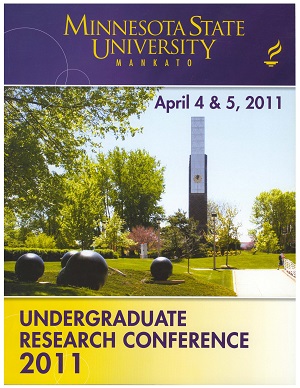NMR Study of Hydroxymethylfurfural (HMF) Reactivity toward Nucleosides of DNA
Location
CSU 253/4/5
Start Date
4-4-2011 11:00 AM
End Date
4-4-2011 12:30 PM
Student's Major
Chemistry and Geology
Student's College
Science, Engineering and Technology
Mentor's Name
Danae Quirk Dorr
Mentor's Department
Chemistry and Geology
Mentor's College
Science, Engineering and Technology
Description
Hydroxymethylfurfural (HMF) is an α,β-unsaturated aldehyde (enal) derived from the dehydration of sugars, notably fructose. HMF is commonly formed in high-fructose corn syrup—a staple ingredient in modern-day food and beverages, among other things—due to heating during storage. Past research involving other enals, such as crotonaldehyde and acrolein, has shown that their bifunctional character enables them to form covalent bonds with 2 nucleotides within DNA simultaneously, forming a cross-link. In order to investigate the potential reactivity of HMF toward DNA, HMF was allowed to react with isolated samples of adenosine, thymidine, cytidine, and guanosine, the four distinct nucleoside building blocks contained in DNA. The resulting products were then examined using NMR spectroscopy to explore their corresponding chemical structures. The NMR spectra were indicative of whether or not a reaction occurred, bonding HMF to a respective nucleoside to generate a new molecule.
NMR Study of Hydroxymethylfurfural (HMF) Reactivity toward Nucleosides of DNA
CSU 253/4/5
Hydroxymethylfurfural (HMF) is an α,β-unsaturated aldehyde (enal) derived from the dehydration of sugars, notably fructose. HMF is commonly formed in high-fructose corn syrup—a staple ingredient in modern-day food and beverages, among other things—due to heating during storage. Past research involving other enals, such as crotonaldehyde and acrolein, has shown that their bifunctional character enables them to form covalent bonds with 2 nucleotides within DNA simultaneously, forming a cross-link. In order to investigate the potential reactivity of HMF toward DNA, HMF was allowed to react with isolated samples of adenosine, thymidine, cytidine, and guanosine, the four distinct nucleoside building blocks contained in DNA. The resulting products were then examined using NMR spectroscopy to explore their corresponding chemical structures. The NMR spectra were indicative of whether or not a reaction occurred, bonding HMF to a respective nucleoside to generate a new molecule.
Recommended Citation
Hovey, Cameron. "NMR Study of Hydroxymethylfurfural (HMF) Reactivity toward Nucleosides of DNA." Undergraduate Research Symposium, Mankato, MN, April 4, 2011.
https://cornerstone.lib.mnsu.edu/urs/2011/poster-session-B/16



